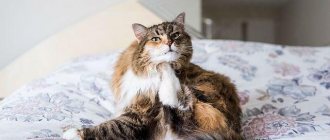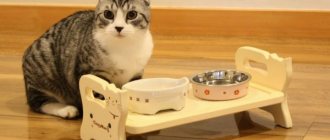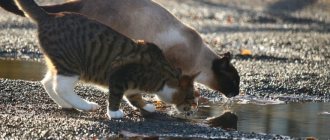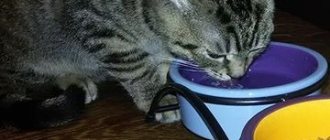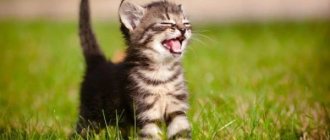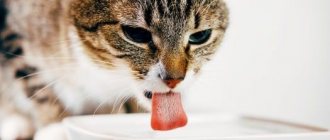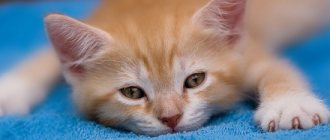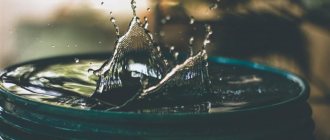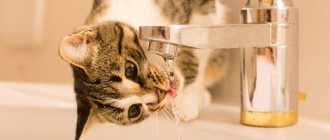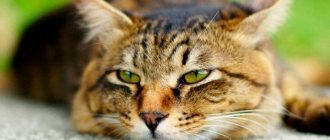Almost all owners of purring pets are familiar with the situation when a cat drinks water from the tap. This is the most common phenomenon in the cat world. Even if the bowl is filled with clean and cool water, the purr will still jump on the sink and demand to open the tap in order to drink from the running water.
The fact of drinking life-giving moisture from the tap pales in comparison with the process itself. Some cats drink water directly by touching the stream with their tongue. Others put their muzzle up and, squinting, lick the drops running down it. And still others prefer to place their paw under the stream, with which they drink water. Sometimes it comes to completely ignoring drinking from a bowl, at least in the presence of the owners, which makes you worry about the health of the animal.
While at home, it’s not at all difficult to go up and open the tap so that your pet gets a drink. But what to do if this is not possible? The option of leaving a dripping faucet not only brings losses, but is also fraught with other problems that could harm neighbors. For example, when the water is turned off and then turned on with stronger water pressure, or the cat accidentally touches an object on the sink, and it blocks the drain.
But this is not the main thing, the most important thing is the health of your beloved pet, and the quality of tap water leaves much to be desired. In some regions the water is too hard, in others it is salty, in others there is a lot of iron or it is full of chlorine. In general, tap water contains salts and various impurities, which can only be purified using a filter. Again, not everyone can afford to install a filter under the sink, providing their pet with purified tap water.
Why do cats ignore the water in their bowl? How can you stop a cat from drinking tap water? Let's figure it out together.
Why does a cat drink tap water?
You've probably noticed that cats love to drink running water, but they go to the bowl less often or even not at all if there is an alternative. This is due to an ancient instinct. The fact is that running water in nature is cleaner than standing water. Therefore, from time immemorial, cats have been looking for murmuring streams and rivers in order to drink cleaner liquid from them. Now the flow of the faucet reminds them of such reservoirs.
Article continues after advertisement
It is also worth considering that if a bowl of water is placed near plates of food, not every cat will want to drink from it. The same ancient instinct is to blame for everything. When a cat eats someone’s carcass in the wild, over time, the remains of the meat release cadaveric poisons into the water nearby. To avoid drinking them, cats look for bodies of water further away. Thus, cats associate water standing near food with poison. No, of course, many cats drink next to food and are fine with standing liquid, but there are also individuals in whom primitive instinct takes over.
Causes of increased thirst
The causes of excessive thirst are not always associated with pathology. These may also be natural physiological causes of a temporary nature.
To understand that the cat is not in danger, you should talk to a specialist.
Factors not related to diseases
A cat will often lap up water if it has been fed salty food. At the same time, it is not necessary to prepare food yourself - salt is also present in purchased food.
There are a number of other physiological causes:
- if it is hot indoors or outdoors and there is low humidity, the cat overheats;
- the same thing happens with an overly active pet;
- a pregnant cat drinks a lot of water for natural reasons: the volume of blood in her body increases, from which the embryos receive nutrients;
- A lactating female also needs a large amount of fluid to produce a sufficient volume of milk.
It is worth taking into account that an animal eating dry food requires more moisture than the calculated norm
Polydipsia caused by pathologies
You should not hope that increased thirst is a physiological phenomenon. You need to carefully monitor your pet to make sure any accompanying symptoms are present.
Diseases that provoke increased thirst
| Diseases | Peculiarities |
| Kidney pathology | Various problems of the urinary system develop (stone disease, nephritis). The main symptom, besides polydipsia, is the cat's frequent trips to the toilet. |
| Thyroid problems | Pets can develop hyperthyroidism. The tumor provokes nausea, which turns into vomiting. The urge to urinate becomes more frequent. The cat eats a lot and loses weight |
| Failure of metabolic processes | Another endocrine problem is diabetes. Due to dysfunction of the pancreas, insulin levels are disrupted. Cells suffer from a lack of glucose, and sugar is actively excreted from the body in the urine. |
| Intoxication | Poisoning can be caused by food, chemicals or their vapors. Against the background of vomiting and diarrhea, a large loss of fluid occurs. Failure of hydrobalance causes the cat to not leave the water bowl |
If an animal, in addition to lapping up a lot of water, eats poorly, or, conversely, does not know what to eat when feeding, this is a clear sign that health problems have arisen.
Vomiting, diarrhea, weight loss, restless or apathetic behavior indicate the seriousness of the pathologies.
Stressful conditions
Some pets easily tolerate traveling in public transport, while others are frightened by the noise of household appliances. Stress in a cat can be caused by various reasons:
- moving to a new place of residence;
- the appearance of other animals in the house;
- the presence of strangers (children and adults);
- separation from the owner;
- switching to other foods.
All these points indicate that cats are emotionally sensitive creatures.
A stressful state is manifested by frequent licking of fur and atypical behavior. The animal loses its appetite, but still drinks a lot of liquid.
Not only diseases lead to the development of polydipsia, but also some drugs prescribed to the cat increase thirst. These may be antibiotics that affect the functioning of the gastrointestinal tract, as well as medications that enhance the function of the diuretic system.
Is tap water harmful to cats?
The water in the tap has a very harmful composition for both humans and animals: it is generously flavored with bleach. The presence of chlorine in water can cause significant harm to the cat’s digestive and urinary systems if such liquid is consumed regularly. In addition, raw tap water may contain other unhealthy impurities and sometimes even infections. This is why cats should not drink tap water on a regular basis.
Many may object by saying that their cats have been drinking tap water all their lives and are healthy. In cats with good immunity and those who are not prone to kidney and bladder diseases, pathology may not develop due to the mere fact of consuming tap water. In addition, representatives of the cat family often get sick without humans noticing. A hidden disease can cause discomfort to the pet, and the owner is the last to know about it. So, if we don’t see something, it doesn’t mean it doesn’t exist.
Reverse osmosis water filters
Stages: 5 stages (mechanical, granular carbon, compressed carbon, reverse osmosis membrane, carbon block). Cartridges can be purchased as one set.
Cleaning: 99.9% contaminants. Complete desalination and disinfection of water. NSF/ANSI Coal Certifications.
Connection: to a cold water supply through a connector with a ball valve.
Filtration speed: Purified water is stored in a 12 liter container. Thus, after draining about 9 liters of clean water, the flow rate will decrease to 150 ml per minute.
Cartridge life: 6 months or 6000 liters, membrane - 1 year or 11,000 liters.
Application: Perfect for apartments, cottages with well water supply.
Pros (+):
- You can drink water without boiling.
- Complete purification, softening and disinfection of water.
- Standard first stage cartridges SL 10″.
- Easy connection and maintenance.
- The pump provides the required pressure.
- High leakage protection and long service life.
Price of reverse osmosis filters
Cost of water purification: First year (including the purchase of a filter and replacing the filter 2 times a year) - 1.5 rubles. per liter, in subsequent years about 40 kopecks per liter.
More filters for washing here
Published: 11/08/2019
Why doesn't my cat drink at all?
Absolutely all cats need to consume life-giving moisture. If the cat is on a natural diet, then it consumes most of the moisture with food, so it drinks less. When feeding factory food, you need to make sure that the cat drinks enough, especially if he eats dry pads.
The rate of water consumption is in the range of 30-40 ml per 1 kg of animal weight per day. This is not only the water from the bowl, but also the liquid contained in the food. If a cat does not consume enough fluid, it becomes susceptible to developing urolithiasis, which is very painful and life-threatening. Don't let this happen!
So, a healthy animal should not have a cat not drink water at all. Perhaps it does this rarely and not in front of you. Perhaps he finds some other sources: for example, a leaking pipe or puddles on the floor. Perhaps you feed it with broths and the animal receives moisture with them. By the way, feeding soups and broths is harmful.
Article continues after advertisement
However, if the cat really does not drink at all, this is a reason to sound the alarm. Refusal to drink fluids is a symptom of diseases, including those that develop rapidly and lead to death. In this case, you should immediately contact a veterinarian, especially if the cat has other signs of illness.
Dangerous symptoms: when should you see a doctor?
Veterinary care is necessary if the cat hardly drinks water or refuses it at all, and the following signs appear:
An animal becomes seriously ill if it develops a specific discharge from the eyes and nose.
- Temperature increase.
- Anxiety, changes in behavior and taste preferences.
- The cat often sits down to pee and urinates blood.
- Pale and dry mucous membranes.
- Constantly meows in pain.
- Vomiting, diarrhea.
- The appearance of ulcers and bleeding in the mouth.
- Frequent swallowing, the cat makes strained attempts to push something out of the mouth.
- Hoarse nasal breathing, snoring during sleep.
- Discharge from nose and eyes.
- The cat constantly spends time lying down, does not get up, and refuses to play.
- Difficulty breathing or shortness of breath.
- Heart dysfunction.
- Decreased sensitivity of the limbs.
- Stickiness, viscosity of saliva.
- Lack of skin elasticity.
- Dramatic weight loss.
How to get a cat to drink water?
How to get a cat to drink clean water that does not flow from the tap? Here are some rules.
- Do not place a bowl of water near food. Some owners even place it in another room.
- You can put not one bowl, but several. Then the cat will see them and remember that he needs to drink.
- Try using a deep transparent bowl. Cats are a fan of these containers.
- Change the water 1-2 times a day. Stagnant water begins to smell unpleasant and loses its taste. Cats drink it extremely reluctantly.
- A ceramic water container is ideal. In second place is glass. The third is stainless steel. The worst option is non-toxic plastic containers. This option comes in last place, because... plastic has wide pores where bacteria become clogged. As a result of the constant exposure of these bacteria to the oral mucosa, some cats develop acne and eosinophilic granuloma.
- The best solution is to buy a special fountain for cats. It creates the effect of running water, so representatives of the cat family enjoy drinking from such devices. In addition, the liquid, as it circulates, is further purified through filters and enriched with oxygen. In this case, the pet will consume more water, which is an excellent prevention of many diseases.
Rate and share!
Lifestyle
During pregnancy, a cat's motor activity usually decreases sharply.
This is not bad, as it reduces the likelihood of accidental injury when jumping. But on the other hand, excessive physical inactivity is also harmful. Low mobility contributes to obesity, and excess weight can complicate childbirth. In the early and middle stages of pregnancy, you need to start quiet games with your cat and make her move a little. In this case, you need to protect the animal from jumping from great heights. A pregnant cat's body becomes heavier, it becomes somewhat clumsy and can be seriously injured during active play. It must be remembered that any injury to the expectant mother during this period can have an extremely negative impact on the kittens. In the later stages of pregnancy, you need to stop any games with the animal. The pet should lie down and rest as much as possible. It is beneficial for a cat to spend most of its time in a state of rest. During this period, you need to take care of her sleep. You should try not to create noise or loud sounds in the room where the animal sleeps. At this time, the body is preparing for future childbirth and needs as much rest as possible. You need to equip a comfortable place to sleep in a bed or house.
If the cat is used to taking daily walks, then in the later stages it is better not to let her out of the house. Otherwise, there is a danger that the birth of kittens will occur in street conditions, which often leads to infection of the babies.

